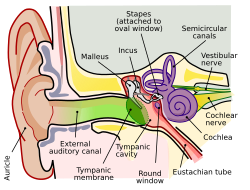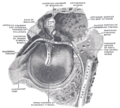Eardrum
| Eardrum or Tympanic membrane Latin = membrana tympani | |
|---|---|
 Anatomy of the human ear. | |
 Right tympanic membrane as seen through a speculum. | |
| Identifiers | |
| MeSH | D014432 |
| TA98 | A15.3.01.052 |
| TA2 | 6870 |
| FMA | 9595 |
| Anatomical terminology | |
The eardrum, or tympanic membrane, is a thin, cone-shaped membrane that separates the external ear from the middle ear in humans and other tetrapods. Its function is to transmit sound from the air to the ossicles inside the middle ear, and then to the oval window in the fluid-filled cochlea. Hence, it ultimately converts and amplifies vibration in air to vibration in fluid. The malleus bone bridges the gap between the eardrum and the other ossicles.[1]
There are two general regions of the tympanic membrane: the pars flaccida (upper region, see picture on right) and the pars tensa. The pars flaccida consists of two layers, is relatively fragile, and is associated with eustachian tube dysfunction and cholesteatomas. The larger pars tensa region consists of three layers: skin, fibrous tissue, and mucosa. It is comparatively robust, and is the region most commonly associated with perforations.[2]
Rupture or perforation of the eardrum can lead to conductive hearing loss. Collapse or retraction of the eardrum can also cause conductive hearing loss or even cholesteatoma.
Parts
The pars tensa forms most of the tympanic membrane. Its periphery is thickened to form a fibrocartilaginous ring called the annulus tympanicus. The central part of the pars tensa is tented inwards at the level of the tip of malleus and is called the umbo. A cone of light can be seen radiating from the tip of the malleus to the periphery in the antero-inferior quadrant. The pars flaccida is situated above the lateral process of the malleus between the notch of Rivinus and the anterior and posterior malleal folds. It appears slightly pinkish.
Relations
The tympanic membrane is superiorly related to middle cranial fossa, posteriorly to the ear ossicles and the facial nerve, inferiorly to the parotid gland and anteriorly to the temporomandibular joint.
Intentional rupture
The Bajau people of the Pacific intentionally rupture their eardrums at an early age in order to facilitate diving and hunting at sea. Many older Bajau therefore have difficulties hearing.[3]
Unintentional rupture
Unintentional rupture of the ear drum has been described in blast injuries during conflict,[4] but also during air travel, usually when the congestion of an upper respiratory infection has prevented equalization of pressure in the middle ear.[5] It is also described in sport and recreation, such as swimming, diving with a poor entry into the water, scuba diving[6] and martial arts.[7] In the published literature, 80% to 95% have recovered completely without intervention in two to four weeks.[8][9] [10] These injuries, even in a recreational or athletic setting, are blast injuries. Many will experience some short-lived hearing loss and ringing in the ear (tinnitus) but can be reassured that this, in all likelihood, will pass. A very few will experience temporary disequilibrium (vertigo). There may be some bleeding from the ear canal if the eardrum has been ruptured. Naturally, the foregoing reassurances become more guarded as the force of injury increases, as in military or combat situations.[10]
See also
Gallery
-
External and middle ear, opened from the front. Right side.
-
Horizontal section through left ear; upper half of section.
-
The right membrana tympani with the hammer and the chorda tympani, viewed from within, from behind, and from above.
-
Auditory tube, laid open by a cut in its long axis.
-
Chain of ossicles and their ligaments, seen from the front in a vertical, transverse section of the tympanum.
-
Right tympanic membrane as seen through a speculum.
References
- ^ Purves D, Augustine GJ, Fitzpatrick D, et al., editors. Neuroscience. 2nd edition. Sunderland (MA): Sinauer Associates; 2001. The Middle Ear. Available from: http://www.ncbi.nlm.nih.gov/books/NBK11076/
- ^ Marchioni D, Molteni G, Presutti L (2011 February). "Endoscopic Anatomy of the Middle Ear". Indian J Otolaryngol Head Neck Surg. 63(2): 101–13. doi:10.1007/s12070-011-0159-0. PMC 3102170. PMID 22468244.
{{cite journal}}: Check date values in:|date=(help)CS1 maint: multiple names: authors list (link) - ^ Guardian
- ^ Ritenour AE, Wickley A, Ritenour JS, Kriete BR, Blackbourne LH, Holcomb JB, Wade CE (2008 Feb). "Tympanic membrane perforation and hearing loss from blast overpressure in Operation Enduring Freedom and Operation Iraqi Freedom wounded". J Trauma. 64(2 Suppl): S174-8.
{{cite journal}}: Check date values in:|date=(help)CS1 maint: multiple names: authors list (link) - ^ Mirza S, Richardson H (2005 May). "Otic barotrauma from air travel". J Laryngol Otol. 119(5) (5): 366–70. doi:10.1258/0022215053945723. PMID 15949100.
{{cite journal}}: Check date values in:|date=(help) - ^ Green SM, Rothrock SG, Green EA= (1993 Oct). "Tympanometric evaluation of middle ear barotrauma during recreational scuba diving". Int J Sports Med. 14(7) (7): 411–5. doi:10.1055/s-2007-1021201. PMID 8244609.
{{cite journal}}: Check date values in:|date=(help)CS1 maint: multiple names: authors list (link) - ^ Fields JD, McKeag DB, Turner JL (2008 Feb). "Traumatic tympanic membrane rupture in a mixed martial arts competition". Current Sports Med Rep. 7(1) (1): 10–11. doi:10.1097/01.CSMR.0000308672.53182.3b. PMID 18296937.
{{cite journal}}: Check date values in:|date=(help)CS1 maint: multiple names: authors list (link) - ^ Kristensen S (1992 Dec). "Spontaneous healing of traumatic tympanic membrane perforations in man: a century of experience". J Laryngol Otol. 106(12) (12): 1037–50. PMID 1487657.
{{cite journal}}: Check date values in:|date=(help) - ^ Lindeman P, Edström S, Granström G, Jacobsson S, von Sydow C, Westin T, Aberg B (1987 Dec). "Acute traumatic tympanic membrane perforations. Cover or observe?". Arch Otolaryngol Head Neck Surg. 113(12) (12): 1285–7. PMID 3675893.
{{cite journal}}: Check date values in:|date=(help)CS1 maint: multiple names: authors list (link) - ^ a b Garth RJ (1995 Jul). "Blast injury of the ear: an overview and guide to management". Injury. 26(6): 363–6. PMID 363-6.
{{cite journal}}: Check|pmid=value (help); Check date values in:|date=(help)






